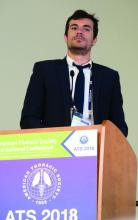SAN DIEGO – for whom conventional stents were not suitable or failed, results from a small study demonstrated.
“Anatomically complex airway stenosis remains a challenging situation,” lead study author Nicolas Guibert, MD, said at an international conference of the American Thoracic Society. “Conventional devices are either not suited or may result in a significant complication rate, including poor clinical tolerance, migration, or granulation tissue reaction due to lack of congruence.”
Dr. Guibert, a pulmonologist at Toulouse (France) University Hospital, and his associates hypothesized that patient-specific, fully customized 3-D stents created by computer-assisted design has the potential for improving tolerance and decreasing the complication rate. In a feasibility study, they recruited 10 patients with nonmalignant, anatomically complex, and symptomatic stenosis for whom conventional stents were not suitable or failed. After computer-assisted segmentation of the airways from a CT-scan and virtual relief of the stenosis, a virtual 3-D stent and corresponding mold was designed for each patient, a process that takes 3-4 weeks, including sterilization. Numerical data were then entered into a 3-D computer numeric control machine to produce the Ertacetal mold, from which the silicon stent is made. The researchers placed the stents under general anesthesia through rigid bronchoscopy and collected data on complication rate, dyspnea as defined by the New York Heart Association classification, quality of life as defined by the VQ11 measure, and respiratory function at day 7 and at 3, 6, and 12 months. Congruence of the stent was assessed preoperatively via bronchoscopy and at 1 week via CT scan.Dr. Guibert reported results from eight patients. Of these, three had posttransplant complex airway stenoses involving the bronchus intermedius. Each improved after placement of the customized stents. For example, one patient with vanishing bronchus intermedius syndrome experienced improvements in NYHA dyspnea score from 3 to 1, the VQ11 score from 22 to 11/55, and forced expiratory volume in 1 second (FEV1) from 70% to 107%. The stent was removed after 3 months. Meanwhile, a patient with localized malacia and stenosis of the right main bronchus experienced improvements in NYHA dyspnea score from 3 to 1, VQ11 score from 27 to 15/55, and FEV1 from 70% to 102%. That person’s stent is still in place with no complications. Another patient with localized malacia and stenosis of the bronchus intermedius experienced improvements in FEV1 from 84% to 100%. That person’s device was removed after 3 months, with no residual stenosis.
A fourth patient underwent stent placement for localized malacia (cartilage ring rupture). That person experienced improvements in NYHA dyspnea score from 3 to 1, VQ11 from 23 to 15/55, and FEV1 from 66% to 92%, and peak flow from 49% to 82%. The device is still in place with no complications. A fifth patient received stent placement for extensive tracheobronchomalacia, but it had imperfect congruence and was removed after 3 months because it caused intense cough.
One patient with post-tracheotomy stenosis experienced improvements in NYHA dyspnea score from 3 to 0, VQ11 from 29 to 12/55, and peak flow from 45% to 81%. That person’s device is still in place, Dr. Guibert said. Two other patients treated for post-tracheotomy experienced stent migration (conventional stents also migrated in these two cases), despite good bronchoscopic congruence after placement.
“Tracheal diseases result in suboptimal congruence, probably due to higher respiratory variation,” Dr. Guibert said. “These devices need to be studied in less selected populations and the technology has to be improved.” He reported having no financial disclosures.
SOURCE: Guibert N et al. ATS 2018, Abstract 4433.

